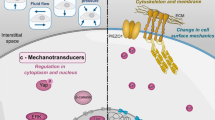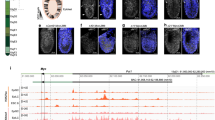Abstract
Tripartite motif 33 (TRIM33), a member of the transcription intermediate factor 1 (TIF1) family of transcription cofactors, mediates transforming growth factor-beta (TGF-β) signaling through its PHD-Bromo cassette in mesendoderm differentiation during early mouse embryonic development. However, the role of the TRIM33 RING domain in embryonic differentiation is less clear. Here, we report that TRIM33 mediates Wnt signaling by directly regulating the expression of a specific subset of Wnt target genes, and this action is independent of its RING domain. We show that TRIM33 interacts with β-catenin, a central player in Wnt signaling in mouse embryonic stem cells (mESCs). In contrast to previous reports in cancer cell lines, the RING domain does not appear to function as the E3 ligase for β-catenin, since neither knockout nor overexpression of TRIM33 had an effect on β-catenin protein levels in mESCs. Furthermore, we show that although TRIM33 seems to be dispensable for Wnt signaling through a reporter assay, loss of TRIM33 significantly impairs the expression of a subset of Wnt target genes, including Mixl1, in a Wnt signaling-dependent manner. Together, our results indicate that TRIM33 regulates Wnt signaling independent of the E3 ligase activity of its RING domain for β-catenin in mESCs.
Similar content being viewed by others
References
Abe, K., and Takeichi, M. (2007). NMDA-Receptor activation induces calpain- mediated β-catenin cleavages for triggering gene expression. Neuron 53, 387–397.
Aucagne, R., Droin, N., Paggetti, J., Lagrange, B., Largeot, A., Hammann, A., Bataille, A., Martin, L., Yan, K.P., Fenaux, P., Losson, R., Solary, E., Bastie, J.N., and Delva, L. (2011). Transcription intermediary factor 1γ is a tumor suppressor in mouse and human chronic myelomonocytic leukemia. J Clin Invest 121, 2361–2370.
Bai, X., Kim, J., Yang, Z., Jurynec, M.J., Akie, T.E., Lee, J., LeBlanc, J., Sessa, A., Jiang, H., DiBiase, A., Zhou, Y., Grunwald, D.J., Lin, S., Cantor, A.B., Orkin, S.H., and Zon, L.I. (2010). TIF1γ controls erythroid cell fate by regulating transcription elongation. Cell 142, 133–143.
Herquel, B., Ouararhni, K., Khetchoumian, K., Ignat, M., Teletin, M., Mark, M., Béchade, G., Van Dorsselaer, A., Sanglier-Cianférani, S., Hamiche, A., Cammas, F., Davidson, I., and Losson, R. (2011). Transcription cofactors TRIM24, TRIM28, and TRIM33 associate to form regulatory complexes that suppress murine hepatocellular carcinoma. Proc Natl Acad Sci USA 108, 8212–8217.
Cheng, M., Xue, H., Cao, W., Li, W., Chen, H., Liu, B., Ma, B., Yan, X., and Chen, Y.G. (2016). Receptor for activated C kinase 1 (RACK1) promotes dishevelled protein degradation via autophagy and antagonizes Wnt signaling. J Biol Chem 291, 12871–12879.
de Boer, E., Rodriguez, P., Bonte, E., Krijgsveld, J., Katsantoni, E., Heck, A., Grosveld, F., and Strouboulis, J. (2003). Efficient biotinylation and single-step purification of tagged transcription factors in mammalian cells and transgenic mice. Proc Natl Acad Sci USA 100, 7480–7485.
Dupont, S., Mamidi, A., Cordenonsi, M., Montagner, M., Zacchigna, L., Adorno, M., Martello, G., Stinchfield, M.J., Soligo, S., Morsut, L., Inui, M., Moro, S., Modena, N., Argenton, F., Newfeld, S.J., and Piccolo, S. (2009). FAM/USP9x, a deubiquitinating enzyme essential for TGFβ signaling, controls Smad4 monoubiquitination. Cell 136, 123–135.
Estarás, C., Benner, C., and Jones, K.A. (2015). SMADs and YAP compete to control elongation of β-Catenin: LEF-1-recruited RNAPII during hESC differentiation. Mol Cell 58, 780–793.
Falk, S., Joosten, E., Kaartinen, V., and Sommer, L. (2014). Smad4 and Trim33/Tif1γ redundantly regulate neural stem cells in the developing cortex. Cerebral Cortex 24, 2951–2963.
Fattet, L., Ay, A.S., Bonneau, B., Jallades, L., Mikaelian, I., Treilleux, I., Gillet, G., Hesling, C., and Rimokh, R. (2013). TIF1gamma requires sumoylation to exert its repressive activity on TGFbeta signaling. J Cell Sci 126, 3713–3723.
Funa, N.S., Schachter, K.A., Lerdrup, M., Ekberg, J., Hess, K., Dietrich, N., Honoré, C., Hansen, K., and Semb, H. (2015). β-Catenin regulates primitive streak induction through collaborative interactions with SMAD2/SMAD3 and OCT4. Cell Stem Cell 16, 639–652.
Hwang, Y., Suk, S., Shih, Y.R., Seo, T., Du, B., Xie, Y., Li, Z., and Varghese, S. (2014). WNT3A promotes myogenesis of human embryonic stem cells and enhances in vivo engraftment. Sci Rep 4, 5916.
Ikeuchi, Y., Dadakhujaev, S., Chandhoke, A.S., Huynh, M.A., Oldenborg, A., Ikeuchi, M., Deng, L., Bennett, E.J., Harper, J.W., Bonni, A., and Bonni, S. (2014). TIF1γ protein regulates epithelial-mesenchymal transition by operating as a small ubiquitin-like modifier (SUMO) E3 ligase for the transcriptional regulator SnoN1. J Biol Chem 289, 25067–25078.
Keller, G.M. (1995). In vitro differentiation of embryonic stem cells. Curr Opin Cell Biol 7, 862–869.
Kim, J., and Kaartinen, V. (2008). Generation of mice with a conditional allele for Trim33. Genesis 46, 329–333.
Lindsley, R.C., Gill, J.G., Kyba, M., Murphy, T.L., and Murphy, K.M. (2006). Canonical Wnt signaling is required for development of embryonic stem cell-derived mesoderm. Development 133, 3787–3796.
Isbel, L., Srivastava, R., Oey, H., Spurling, A., Daxinger, L., Puthalakath, H., and Whitelaw, E. (2015). Trim33 binds and silences a class of young endogenous retroviruses in the mouse testis; a novel component of the arms race between retrotransposons and the host genome. PLoS Genet 11, e1005693.
Many, A.M., and Brown, A.M.C. (2014). Both canonical and non-canonical Wnt signaling independently promote stem cell growth in mammospheres. PLoS ONE 9, e101800.
Massagué, J. (2012). TGFβ signalling in context. Nat Rev Mol Cell Biol 13, 616–630.
Massagué, J., and Xi, Q. (2012). TGF-β control of stem cell differentiation genes. FEBS Lett 586, 1953–1958.
Morsut, L., Yan, K.P., Enzo, E., Aragona, M., Soligo, S.M., Wendling, O., Mark, M., Khetchoumian, K., Bressan, G., Chambon, P., Dupont, S., Losson, R., and Piccolo, S. (2010). Negative control of Smad activity by ectodermin/Tif1gamma patterns the mammalian embryo. Development 137, 2571–2578.
Singh, A.M., Reynolds, D., Cliff, T., Ohtsuka, S., Mattheyses, A.L., Sun, Y., Menendez, L., Kulik, M., and Dalton, S. (2012). Signaling network crosstalk in human pluripotent cells: a Smad2/3-regulated switch that controls the balance between self-renewal and differentiation. Cell Stem Cell 10, 312–326.
Dupont, S., Zacchigna, L., Cordenonsi, M., Soligo, S., Adorno, M., Rugge, M., and Piccolo, S. (2005). Germ-layer specification and control of cell growth by ectodermin, a Smad4 ubiquitin ligase. Cell 121, 87–99.
Stewart, S.A. (2003). Lentivirus-delivered stable gene silencing by RNAi in primary cells. RNA 9, 493–501.
ten Berge, D., Koole, W., Fuerer, C., Fish, M., Eroglu, E., and Nusse, R. (2008). Wnt signaling mediates self-organization and axis formation in embryoid bodies. Cell Stem Cell 3, 508–518.
Vincent, D.F., Gout, J., Chuvin, N., Arfi, V., Pommier, R.M., Bertolino, P., Jonckheere, N., Ripoche, D., Kaniewski, B., Martel, S., Langlois, J.B., Goddard-Léon, S., Colombe, A., Janier, M., Van Seuningen, I., Losson, R., Valcourt, U., Treilleux, I., Dubus, P., Bardeesy, N., and Bartholin, L. (2012). Tif1γ suppresses murine pancreatic tumoral transformation by a Smad4-independent pathway. Am J Pathol 180, 2214–2221.
Wang, L., and Chen, Y.G. (2016). Signaling control of differentiation of embryonic stem cells toward mesendoderm. J Mol Biol 428, 1409–1422.
Weng, L., Mitoma, H., Tricot, C., Bao, M., Liu, Y., Zhang, Z., and Liu, Y.J. (2014). The E3 ubiquitin ligase tripartite motif 33 is essential for cytosolic RNA-induced NLRP3 inflammasome activation. J Immunol 193, 3676–3682.
Xi, Q., Wang, Z., Zaromytidou, A.I., Zhang, X.H.F., Chow-Tsang, L.F., Liu, J.X., Kim, H., Barlas, A., Manova-Todorova, K., Kaartinen, V., Studer, L., Mark, W., Patel, D.J., and Massagué, J. (2011). A poised chromatin platform for TGF-β access to master regulators. Cell 147, 1511–1524.
Xue, J., Chen, Y., Wu, Y., Wang, Z., Zhou, A., Zhang, S., Lin, K., Aldape, K., Majumder, S., Lu, Z., and Huang, S. (2015). Tumour suppressor TRIM33 targets nuclear β-catenin degradation. Nat Commun 6, 6156.
Acknowledgements
We thank Professor Wei Wu (Tsinghua University) for providing the 7xTcf-eGFP/SV40-mCherry plasmid. We also thank Professor Ye-Guang Chen (Tsinghua University) for providing the TOP-FLASH luciferase reporter, FOP-FLASH luciferase reporter, pRL-TK Renilla reporter, and luciferase reagent. This work was supported by the National Natural Science Foundation of China (20141300584, 20151301548 to Qiaoran Xi), and the THU-PKU Center for Life Sciences.
Author information
Authors and Affiliations
Corresponding author
Rights and permissions
About this article
Cite this article
Xia, X., Zuo, F., Luo, M. et al. Role of TRIM33 in Wnt signaling during mesendoderm differentiation. Sci. China Life Sci. 60, 1142–1149 (2017). https://doi.org/10.1007/s11427-017-9129-3
Received:
Accepted:
Published:
Issue Date:
DOI: https://doi.org/10.1007/s11427-017-9129-3




